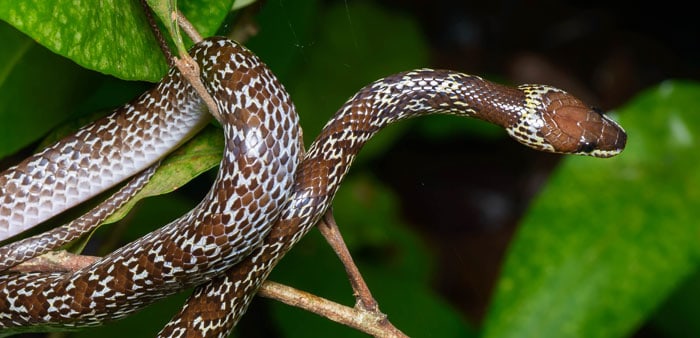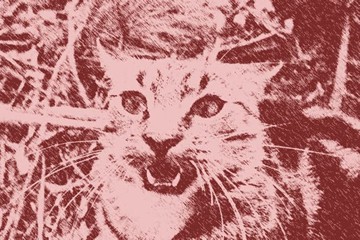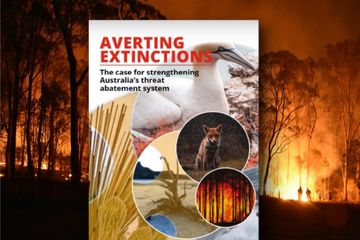
The new Action Plan for Australian Lizards and Snakes 2017 establishes for the first time that Australia’s lizards and snakes are more at risk from invasive species than anything else.
Invasive species and diseases threaten 138 (14.6%) species, followed by agriculture, which harms 118 (12.4%). Fire threatens 79 species and climate change (and severe weather) 36.
The invasive species of concern include cats, foxes, cane toads, sambar deer, red deer, horses, pigs, black rats, Polynesian rats, wolf snakes, Asian house geckoes, yellow crazy ants, Phytophthora, and a slew of weeds.
The Christmas Island forest skink (Emoia nativitatis) is recently extinct, and Lister’s Gecko (Lepidodactylus listeri) and the blue-tailed skink (Cryptoblepharus egeriae) are extinct in the wild, all victims of wolf snake (Lycodon capucinus) predation on Christmas Island.
In earlier assessments of these lizards some blame was put on cats, black rats and Asian centipedes, and that remains the case in this action plan, but the view is firming that wolf snakes are overwhelmingly the reason these lizards were lost. Skinks and a gecko were found inside wolf snakes dissected around the time the lizards disappeared from the wild.
Cane toads are harming a range of goannas and snakes susceptible to toad toxin, especially the endangered Merten’s water monitor (Varanus merteni) and critically endangered Mitchell’s water monitor (V. mitchelli). These lizards occupy many remote wilderness areas such as Kimberley gorges, but cane toads are finding their way into these.
Weed experts haven’t found it easy to convince Australians that weeds can cause extinctions, but this report will help change that. It mentions a wide range of reptiles harmed by a wide range of weeds, including grader grass, Indian couch, rubber vine, lantana, Scotch broom and cats claw creeper.
Buffel grass (Cenchrus ciliaris) comes up the most, as a highly invasive pasture grass that fuels fierce fires.
‘Habitat degradation by weeds is considered to affect many more species now than was the case in 1993,’ the report says, ‘with most of this impact relating the habitat degradation and changes in fire intensity associated with broadscale expansion of the introduced buffel grass in arid and semi-arid Australia.’
The species at risk include three critically endangered lizards, two endangered lizards and three vulnerable lizards, although each faces other threats as well. For example, the critically endangered gravel-downs ctenotus (Ctenotus serotinus), an inland skink, is losing out to cats, foxes and buffel invasion, which has escalated in the past decade.
For the endangered yellow-snouted ground gecko (Lucasium occultum) of the Kakadu region, gamba grass (Andropogon gayanus), another pasture grass, is its number one threat. Kakadu has other rare reptiles that will lose out if this grass keeps spreading.
A different kind of example is the endangered Nangur skink (Nangura spinosa), confined to two patches of dry rainforest in southern Queensland. Most of the population occurs in Oakview National Park, in which the lizard has lost out to dense stands of lantana (Lantana camara), giant rat’s tail grass (Sporobolis species), cat’s claw creeper (Dolichandra unguis-cati) and coral berry (Ardisia crenata). The weeds are increasingly shading the burrow entrances at which the lizards bask.
Red deer are worsening matters by compacting soil and destroying burrow entrances, and foxes, pigs and cats are thought to pose threats as well. This lizard has very high conservation value as the only member of its genus.
In alpine regions anyone who didn’t know better might think climate change would top the list of threats but it has to compete with ski resort development and various invasive species. The endangered alpine she-oak skink (Cyclodomorpgus praeltus) has to contend with black rats, cats, wild dogs and orange hawkweed (Hieracium aurantiacum) invasion. The endangered alpine bog skink (Pseudomoia cryodroma) has cats, foxes, deer and feral horses to contend with, and the endangered Guthega skink (Liopholis guthega) also has pigs messing up its habitat.
This report doesn’t assess turtles, but if it had, the problem of pigs, foxes and wild dogs digging up eggs would be issues of note. On Cape York Peninsula, for example, feral pigs, in the absence of control, prey heavily on eggs of endangered olive ridley turtles.
The Action Plan for Australian Lizards and Snakes 2017 (2019) David G. Chapple, Reid Tingley, Nicola J. Mitchell, Stewart L. Macdonald, J. Scott Keogh, Glenn M. Shea, Philip Bowles, Neil A. Cox, John Z. Woinarski CSIRO, RRP $160.








